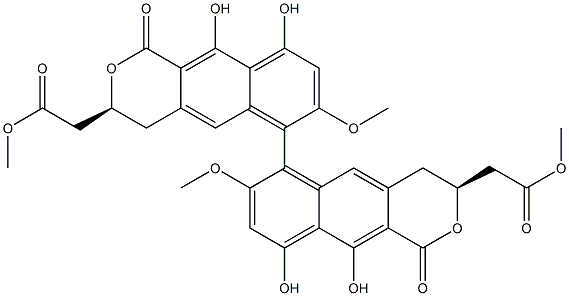Description
(−)-Viriditoxin is a mycotoxin originally isolated from
A. viridinutans that has antibacterial and antiproliferative activity. It is active against methicillin-sensitive and -resistant
S. aureus (MSSA and MRSA, respectively), tetracycline-sensitive and -resistant
Staphylococcus, vancomycin-sensitive and -resistant
Enterococcus, and penicillin-sensitive and -resistant
S. pneumoniae (MICs = 2-32 μg/ml). (−)-Viriditoxin is also active against fish pathogens, including
S. iniae and
S. parauberis (MICs = 0.16-0.21 μg/ml). It inhibits polymerization and the GTPase activity of
E. coli FtsZ, a tubulin-like GTPase involved in bacterial cell division (IC
50s = 8.2 and 7 μg/ml, respectively). (−)-Viriditoxin inhibits proliferation of human DU145, LNCaP, and PC3 prostate cancer cells (IC
50s = 5.36, 0.63, and 7.6 μM, respectively) . It is also toxic to mice (LD
50 = 2.8 mg/kg, i.p.).
Definition
ChEBI: (M)-viriditoxin is a dimethyl 2,2'-(9,9',10,10'-tetrahydroxy-7,7'-dimethoxy-1,1'-dioxo-3,3',4,4'-tetrahydro-[6,6'-binaphtho[2,3-c]pyran]-3,3'-diyl)diacetate in which the the 3 and 3' positions (bearing the 2-methoxy-2-oxoethyl (CH2CO2Me) groups) both have S configuration, while the 6 and 6' positions (where the binaphthopyran units are linked) have Ra configuration (the M atropisomer). It has been isolated from the fungi Aspergillus viridinutans and the fungus Paecilomyces variotii derived from the inner tissues of the giant jellyfish Nemopilema nomurai. It has a role as a mycotoxin, an Aspergillus metabolite and an antibacterial agent. It is functionally related to a semiviriditoxin.


